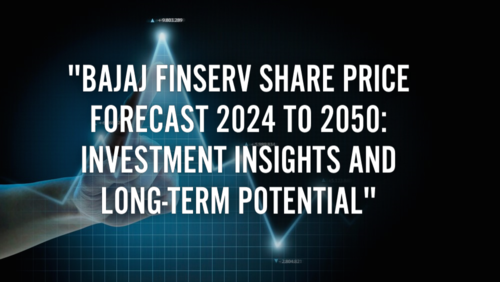SBI Share Price Target 2024,2025,26,27,28,29,30 To 2035
Get the latest SBI share price target forecast from 2025 to 2035, including factors influencing its growth and financial …

Bajaj Finserv Ltd. (NSE: BAJAJFINSV) is one of India’s most prominent financial services organizations, providing an array of services in insurance, lending, and wealth management. This article will analyze Bajaj Finserv’s projected share prices for the years 2024 through 2050 based on current market trends and company fundamentals.
As a part of the Bajaj Group, Bajaj Finserv operates through various subsidiaries that cover consumer finance, life insurance, and general insurance. With a focus on digital transformation and customer-centric innovation, the company has carved a significant niche in the financial services industry.
Visit Bajaj Finserv for more information
Below is a snapshot of Bajaj Finserv’s financial health:
| Metric | Value |
|---|---|
| Market Cap | ₹243,382 Crore |
| P/E Ratio | 32.25 |
| Book Value | ₹1,239 |
| Dividend Yield | 0.49% |
| ROCE | 11.9% |
| ROE | 22.0% |
| Debt to Equity | 3.82 |
| Promoter Holding | 60.78% |
| EPS (TTM) | ₹233 |
Despite global economic challenges, Bajaj Finserv is expected to remain resilient. Leveraging its technological initiatives and diversified portfolio, our 2024 price target is projected between ₹1,400 and ₹2,600.
| Month | Minimum Price (₹) | Maximum Price (₹) |
|---|---|---|
| January | 1,500 | 1,800 |
| February | 1,500 | 1,750 |
| March | 1,500 | 1,650 |
| April | 1,500 | 1,700 |
| May | 1,400 | 1,600 |
| June | 1,400 | 1,600 |
| July | 1,500 | 1,650 |
| August | 1,500 | 1,800 |
| September | 1,600 | 2,200 |
| October | 1,600 | 2,000 |
| November | 1,500 | 2,500 |
| December | 1,700 | 2,600 |
With a strong brand presence and a continued push toward digital and tech-enabled solutions, Bajaj Finserv is forecasted to see stable growth in 2025. The price range for 2025 is anticipated to be ₹2,100 to ₹4,500.
| Month | Minimum Price (₹) | Maximum Price (₹) |
|---|---|---|
| January | 2,100 | 3,000 |
| February | 2,200 | 3,500 |
| March | 2,250 | 3,300 |
| April | 2,300 | 3,300 |
| May | 2,300 | 3,500 |
| June | 2,400 | 3,400 |
| July | 2,400 | 3,600 |
| August | 2,450 | 3,600 |
| September | 2,500 | 3,800 |
| October | 2,500 | 3,900 |
| November | 2,530 | 4,500 |
| December | 2,680 | 4,500 |
By 2030, Bajaj Finserv is likely to continue its expansion, benefiting from enhanced digital infrastructure and a focus on customer experience. The price range for 2030 is expected to be ₹15,000 to ₹17,000.
| Month | Minimum Price (₹) | Maximum Price (₹) |
|---|---|---|
| January | 15,000 | 15,200 |
| February | 15,200 | 15,400 |
| March | 15,400 | 15,600 |
| April | 15,600 | 15,800 |
| May | 15,800 | 16,000 |
| June | 16,000 | 16,200 |
| July | 16,200 | 16,400 |
| August | 16,400 | 16,600 |
| September | 16,600 | 16,800 |
| October | 16,800 | 17,000 |
| November | 16,900 | 17,000 |
| December | 17,000 | 17,000 |
For 2040, the projected share price is estimated between ₹30,000 and ₹35,000, while 2050 predictions are more uncertain, ranging from ₹50,000 to ₹60,000, provided Bajaj Finserv sustains growth and adapts to new market conditions.
Analysts highlight Bajaj Finserv’s robust growth trajectory, driven by its diversified revenue model and continuous technological investments. Potential risks include regulatory challenges and competitive pressures from fintech and established peers.
Bajaj Finserv has demonstrated a consistent ability to innovate and adapt. While it shows strong potential for long-term gains, investors should weigh potential regulatory risks and market volatility. Consulting a financial advisor and conducting thorough research is crucial before making investment decisions.
What does Bajaj Finserv primarily do?
Bajaj Finserv is involved in various financial services, including consumer finance, life insurance, and general insurance.
Has Bajaj Finserv performed well recently?
Yes, the company has posted strong earnings growth, supported by its diversified business operations.
What are the main drivers of growth for Bajaj Finserv?
Technological investments, the expansion of financial services in under-penetrated areas, and increasing demand for insurance and wealth management services are key growth drivers.
Is Bajaj Finserv a good long-term investment?
While promising, investors should carefully consider their financial goals and risk tolerance.
What are the risks associated with investing in Bajaj Finserv?
These include potential regulatory changes, economic fluctuations, and competition from new market entrants.